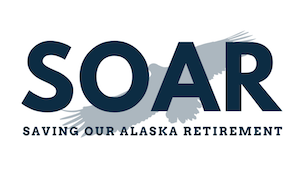
Saving Our Alaska Retirement (SOAR) is an NEA-Alaska committee dedicated to ensuring Alaska educators have access to a secure retirement after their service to our public schools. In 2006, Alaska abandoned its defined benefit retirement system and put in place a defined contribution system. This change has left all public sector workers hired since then without any guaranteed income in retirement. This fact, coupled with the reality that most Alaska educators do not participate in Social Security, has created a perfect storm of financial insecurity.
Since 2006, NEA-Alaska has been advocating for a return to a defined benefit system. Our association has supported legislation and built coalitions with other public sector unions to advance our cause. Unfortunately, these efforts have encountered considerable political pushback and have never come to fruition. The SOAR committee is working to change this.
This group shares critical information regarding Alaska retirement plans, financial services available to NEA-Alaska members, and conducts research and analysis of pertinent financial information which is shared with educators and policymakers. SOAR committee members are appointed by the NEA-Alaska President from each of our 7 Regions as well as At-Large members with valuable experience navigating the complex web of retirement issues.
Please use and share this site to gain insight into our ongoing work, increase our capacity to engage legislators, and join our movement to create real change for Alaska working people.
FAQ
Retirement is a complicated subject with very few one size fits all answers. Whether you’re an early career educator looking for ways to diversify your retirement savings, or you’re nearing the end of your career, there is an abundance of information available to you. Below are some of the most frequently asked questions we hear from Alaska educators.
Issues
Understanding all of the issues impacting our retirement system can be overwhelming. With local, state, and federal programs overlapping and impacting one another, it’s important to evaluate your individual situation when planning for retirement. The section below will help you assess the overall retirement system for Alaska educators and gain knowledge that can be useful in making informed decisions. As always, working closely with a professional financial planner is the best way to build a plan for your retirement.
Resources
- Alaska Public Pension Coalition 2024 Talking & Data Points
- Senate Bill 88 Summary Sheet
- ARTICLE: No Social Security? For Alaska teachers, that’s just the way it is
- ARTICLE: This is what teacher turnover looks like in Alaska
- ARTICLE: Alaska teachers wonder: Should they stay or should they go?
- State of Alaska Retirement and Benefits
- Financial Basics Presentation
- Retirement Checklist Brochure
- The Financial Realities of Working as an Educator in Alaska
- Recent History of Alaska’s Retirement Systems
- NEA-Alaska Retirement Resources Guide
NEA Membership
NEA-Alaska/Retired Membership
As a retired member, you can continue to participate in NEA-Alaska at every level. You’ll support Alaska’s premier watchdog on retirement issues, legislation that impacts retirees and TRS/PERS issues. You’ll also add your voice to NEA-Retired, protecting your interests on the federal level.
Pre-Retired Membership
Still working? Join Pre-Retired for a lifetime of continued support and benefits after you retire. Select a payment plan that works best for you and become a fully paid-up member while you’re still in your earning years.
Learn More
Do More
Achieve with NEA-Alaska



